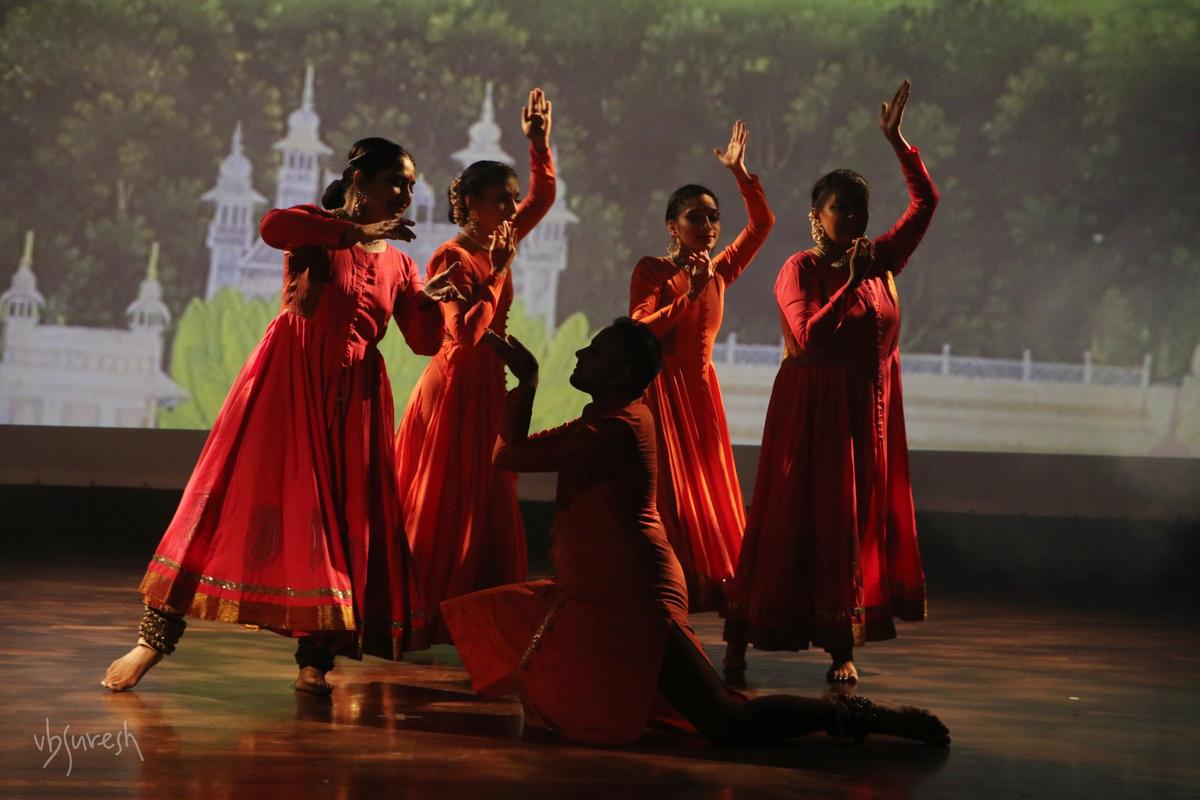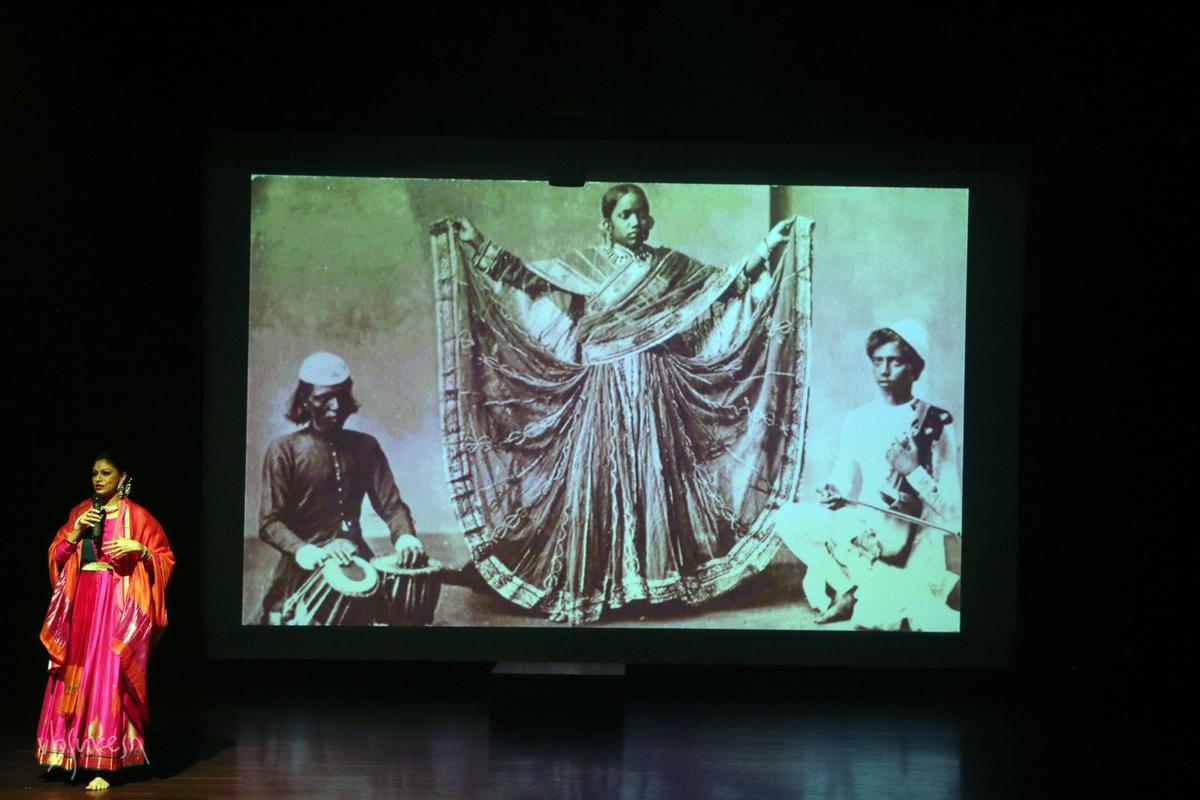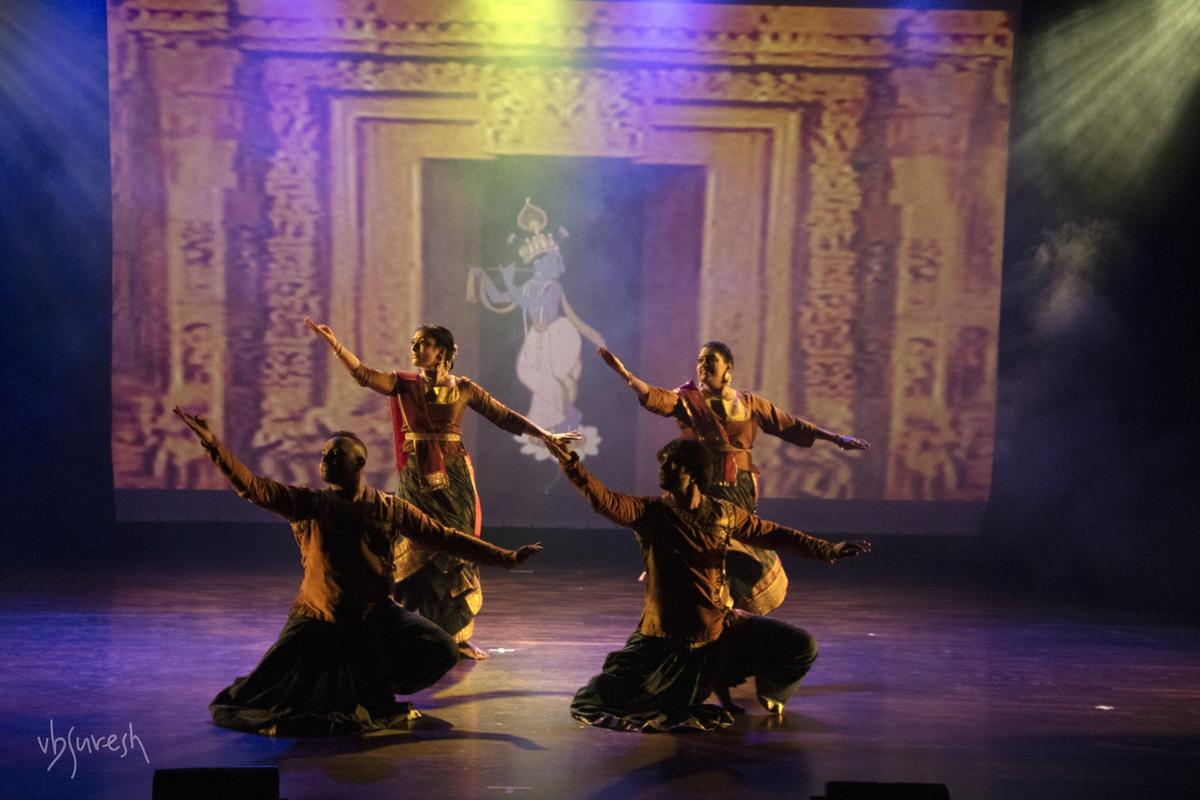
Madhu Natraj presented ‘Kathas in Kathak’ at the Bangalore International Centre.
| Photo Credit: Photo: Suresh Babu
‘Kathas in Kathak,’ presented by Natya STEM Dance Kampni at the Bangalore International Centre (BIC), was a dance between swirling and stillness, history and modernity, silence and the music of resurgence. While each aspect of this dance had its own textures, colours and vocabularies, a unified language, cultivated by the dancers in body, mind, and spirit shone through.
Introducing Kathak as the form that has taken the maximum number of ‘onslaughts, invasions and bans,’ Madhu Nataraj, founder, STEM Dance Kampni, and Director, Natya Institute of Kathak and Choreography (the two entities that make Natya STEM Dance Kampni), set the tone for an evening of storytelling on storytellers and their form, Kathak – that, curiously, was once a word for “storytellers.”

Dancers at the performance.
| Photo Credit:
Photo: Suresh Babu
Leisurely pace
The programme’s pace was leisurely, though we travelled through many centuries, going back and forth from the past to the future, collecting (sometimes startling) new insights on mythology, and refreshing perspectives on textbook histories. The interactive nature of the performance afforded more access to understanding a classical dance form that has clearly evolved in rhythm with everything that was happening around it. We learnt how gracefully the form spoke when silenced; how it tweaked and tuned its motifs according to the times. Every item performed by the seasoned, much-travelled ensemble of dancers, told of Kathak’s pluralistic roots, its resilience and tendency to daringly reinvent itself and better tell its tales.
Starting with a well-synchronised piece on Kathak’s earlier avatar during the times when Vaishnavism reigned in parts of India, ‘Kathas in Kathak’ took us, in a leap, across the centuries when the ghunghroos of temple dancers fell silent, only to emerge again in the bodies of court dancers wearing their ingenuity in freshly fashioned ornaments of dance. This pattern of demonstrating Kathak’s transformation with historical contexts ran parallel with a rich, visual narration of its power to transform storytellers’ voices and foster social agency.

Madhu Natraj provided a peek into the dance form’s history.
| Photo Credit:
Photo: Suresh Babu
Interesting insights
From the artistic morphing of Krishna’s depiction into “begum ki muskurahat” to the demonstration of Kathak’s inherent ability to hold gendered issues like cross-dressing ever so lightly, the pieces simultaneously brought delight and information to the audience, without distancing them through displays of just technical skill. In the context of “globalisation and polarisation,” to quote Madhu Nataraj, who strung the show together with her gently told, in-depth chronicles, one could appreciate the importance of this dance form’s journey. And quite the same way, the unfair erasure of courtesans’ contributions to nurturing this form, was effectively conveyed. Rare, vintage choreographies held the audience in thrall as did modern ones addressing pressing issues like climate change.
‘Kathas in Kathak’ was presented at BIC as part of the ongoing celebrations of 60 years of Natya Institute, started in 1964 by two pioneering women, Maya Rao and Kamaladevi Chattopadhyay. The intention of keeping culture alive in all its wholesomeness, and for its own sake – not as “a crutch for a festival or annual day programme,” has ensured that Natya has stayed relevant for 60 years, “going way beyond the prevalent start-up culture,” says Madhu. This has been made possible through a core belief that “the role of dance institutions is to be nerve centres that create eco-systems,” she adds.
Six-decade journey

The performance highlighted how new stories are being narrated through Kathak.
| Photo Credit:
Photo: Suresh Babu
“To mark the six eventful decades, 60 collaborations are being dreamed of and acted on, of which 24 are already underway or completed”, she says. Believing that “collaboration gives you the power to harness the idea of collective action, whether in artistry or social change,” Madhu has followed in the footsteps of her mentor and mother Maya Rao, under whom she trained closely. The early collaborations of Natya Institute with the likes of Anil Biswas and Dagar Brothers have set the stage for the ones now being developed in domains as varied as climate action and social change, she shares.
“Kathak, in its DNA, is the essence of pluralism,” says Madhu, while talking about the form that has aligned with India’s innate tendency to be pluralistic, and that has constantly shaped itself according to influences of the time. She also stresses the need she has felt as a feminist, to take a stance against propagating parochialism or patriarchy through dance. This means having to constantly dialogue with arts organisers and apply sensitivity to artistic depictions of traditional stories, especially mythologies handed down over the ages. These and other aspects of Natya Institute’s practice percolated through the carefully cultivated lens of Natya STEM Dance Kampni’s ‘Kathas in Kathak’, where every story was told in rhythm with a deeply felt need for building connection.
Published – September 21, 2024 06:31 pm IST
